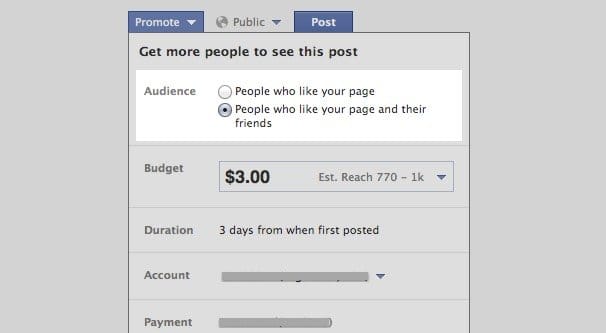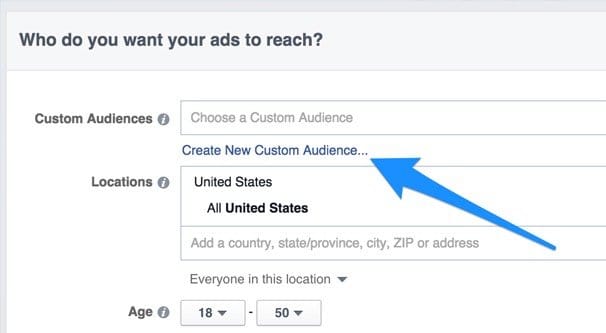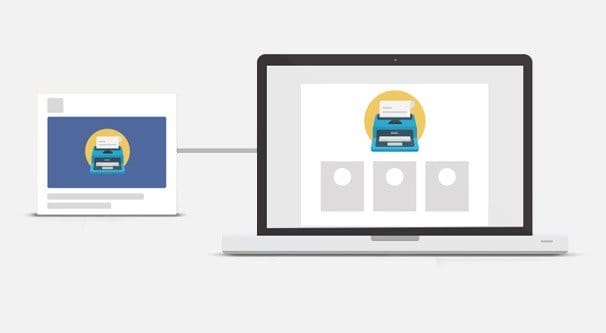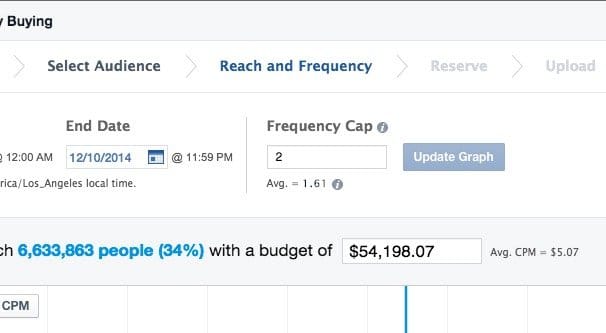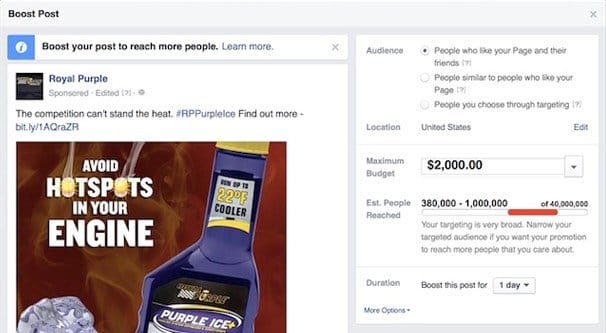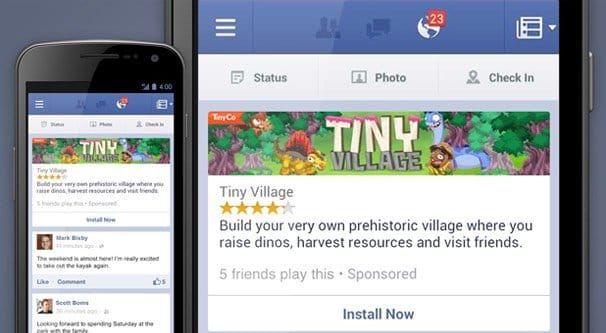 Written by ContentPowered.com
Written by ContentPowered.com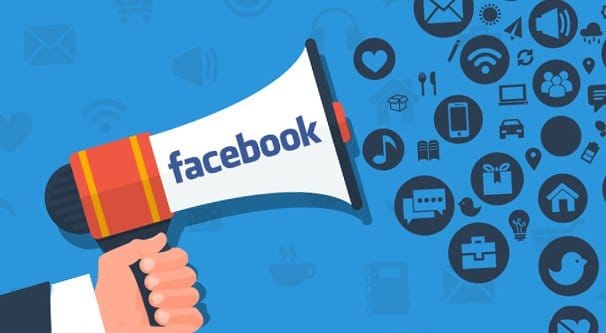
Facebook is a unique ads platform in that it has such a wealth of information you can use for targeting, along with all of the different ad formats and ad objectives. There are a million and one things you can tweak for your ads, so improving them can be at once easy and a monumental task.
One thing I often see with marketers is getting caught in a rut. We get used to the same five or six methods of optimization, and when those prove ineffective or peter out, we’re lost. That’s why I put this list together; to help other marketers use it as an ideas list for conversion optimization tweaks. If what you’re doing isn’t working, try a few of these. Something’s going to work, sooner or later.
1. Be Very Specific with Targeting Factors
Facebook has dozens of targeting factors, and you can use as few or as many as you want in every ad. The more factors you include, the smaller your audience will be, but the more focused they will be. When you come up with a buyer persona – the kind of person you’re specifically trying to reach – you can target to match them and have very focused advertising. The more specific you can be, the better off you’ll be.
2. Advertise Solely to Your Audience
One tip that Jon Loomer – Facebook ads guru – uses is to restrict his advertising to just his page followers. This is good for some ads, particularly those selling your products, because you already know they’re interested and they’re part of your sales funnel.
It’s not great for attracting new users, though, for obvious reasons. I recommend it as a narrow audience for certain ads, but make sure the ads you’re using match the intent behind the audience you’ve chosen.
3. Create and Utilize a Lookalike Audience for Page Likes
Your audience is made up of a certain type of person, primarily. The more narrow your business niche, the more specific that type of person will be. You can use Facebook’s lookalike audience feature to create a targeted audience that matches the demographics and interests of your audience, but who don’t already follow you. This is a perfect audience to use to attract new followers to your page, to then target with audience-only ads.
4. Don’t Be Afraid to Make More Audiences
Seriously. I’ve seen the inside of successful businesses in their ads manager and they have dozens or, in some cases, hundreds of saved audiences.
These narrow custom targets represent individual buyer personas and individual types of ad objectives. Always have a few ads running with new audiences, simply to see if those audiences work for you. Don’t know how to find them? Here are some ideas.
5. Minimize the Text in Your Ad Images
Facebook changed their text rules for ads in the news feed. Formerly, they would be rejected if you went over the 20% text threshold. This was an inelegant and oft-maligned system that was retired for good reason. Nowadays, you can run ads with almost as much text as you want, but the more text they have, the more expensive they will be, and the less exposure they will get. This is Facebook’s new system, and it’s an even better encouragement for brands to keep their text-in-images down. Also, remember that sidebar ads are exempt from this, so use all the text you want there.
6. Experiment with Different Types of Ad Images
Images can vary wildly from ad to ad, even with the same copy. You might be testing a picture of a landscape, a picture of a smiling woman, a picture of a salad, and a picture of a plane all with the same copy, and they all make equal sense. You never know what’s going to work and what isn’t, so always be testing different images. I recommend having at least three variations of almost every ad running at any given time, just so you get as much data as you possibly can.
7. Make Sure Your Landing Page is Tailored to Convert
There’s more to ad optimization than just the ad itself. You also need to dig into the wonderful world of conversion rate optimization on your landing page. It’s one thing to get a bunch of people from your ad to a landing page, but it’s quite another to get them to take action on that landing page.
Even when the conversion is simple, like an email opt-in, don’t underestimate the value of conversion optimization!
8. Make Sure Your Landing Page matches Your Advertising
Relevance between your ads and your landing pages is very important. Think about the past, and how you would quite often click an ad or a link only to find yourself on a page that looks completely unrelated. How often did that happen? How often did you then read the page you landed on and go on to convert? Chances are, not very often on that second count. You need consistency with your message, which means making individual landing pages for narrow ads, meaning you might need dozens of customized landing pages on your site.
9. Run More Ads for Less Time and Money
The key to optimization is testing, and the key to testing is variety and volume. You should have dozens of ad sets, each with at least four or five variations of each ad within them, testing to see which works better. Don’t run them for high budget blasts; run them in small batches, for a few days or weeks depending on the exposure they get. Run them only long enough to get a statistically valid sample, which you can then compare so you can find which ad variation worked best. Then, and only then, can you turn up the budget on that ad and run it on blast to get as much out of it as possible.
10. Don’t Let Frequency Surpass Ideal Limits
Ad frequency is an estimation of the number of times each person in your audience has seen your ad. If your audience has 100 people in it, an ad frequency of 1 means each users has seen it once.
A frequency of 2 means they’ve seen it twice, and a frequency of .5 means only half of them have seen it. Of course, there’s some overlap; a frequency of 1 might still mean 50 of the people saw the ad once and 12 of them saw it twice each for a total of 100 views, but over larger audiences it equalizes. What, then, is an ideal frequency? Data suggests around one.
11. Focus on Improving your Facebook Relevance Score
Facebook relevance score is a metric that measures the positive and negative feedback on your ads over time and ranks them, as well as predicting how new ads will perform based on common qualities and your past performance. A better relevance means more exposure for less cost, so it’s good to improve it. Keep an eye on it and try to improve or cull the weakest ads in your arsenal.
12. Attach Compelling Offers to Ads
Sometimes it’s not about what you say, it’s about what you’re giving away. A good incentive, presented in the right way, can make your ads skyrocket in conversion rate. Of course, you have to know what kind of offer is attractive to your users and how you can give it to them without compromising your business. When you do, though, you can create an audience out of the people who convert for that, and use that for a more targeted ad later.
13. Don’t Use the Default Boost Post Button
The Boost Post button is something of a trap. It lacks some of the fundamental options granted to you by creating ads from scratch.
There are a few cases where you can use it successfully, and it’s not as bad as it used to be, but it’s still generally better to create new ads in your ads manager than it is to just boost an existing post. The exception is if that post is already going viral, in which case adding a bit of a boost can take it to new heights.
14. Make Use of Advanced Features in Power Editor
The Facebook Power Editor is a powerful tool, for two reasons. First, it puts many of the advanced features of the ads manager right front and center. Consider it an advanced tool, where the ads manager is basically an introductory tool. Secondly, when Facebook wants to test a new feature, the roll it out to Power Editor first. This gives you the chance to test new features before the rest of the crowd. This can be quite the leg up, especially over competition that isn’t on the ball.
15. Wait for a Significant Sample Size Before Making Changes
I mentioned this above, with a link even, but it’s worth reiterating. It’s tempting to see a hint of negative data and kill an ad, but that can just mean a downswing during a slow day, or the reverse. Always wait for enough data to make informed decisions before you boost or kill an ad.
16. Use the Right Positions for Your Message and Objective
Different ad positions are better for different objectives. Sidebar ads are garbage for just about everything except brand awareness and page likes, and sometimes apps. Mobile ads are great for app installs and engagement.
News feed ads can be used for many offers and assorted objectives, but require a lot of work to optimize for deep objectives and might fail for app-based objectives.
17. Set Specific Ad Schedules for Optimal Timing
Facebook lets you be very specific about when your ads run, even down to the specific hours of specific days of the week. Abuse this feature to make sure your best ads are running at the best times for your audience. How do you figure out when the best time is? There are guides for that, and it will be different for everyone.
18. Avoid the Generic Call to Action
How often do you actually click when you see “click here”? Using a specific call to action can be much more effective than the generic options. Ideally, you will match the call to action to the ad objective itself. Don’t use “buy now” when the landing pages wants users to sign up for a mailing list, for example.
19. Make Use of Video Ads
Video ads are relatively new on Facebook, and they’re heavily pushed because Facebook wants to compete with YouTube. This will only further be pushed now that Twitter has retired the Vine video service. A lot of content creators will be looking for homes, and Facebook will want to capture them. By taking advantage of videos, you can ride that trend.
2o. Use a Pixel to Create a Remarketing Audience
Facebook pixels on your website track people who reach and perform certain objectives.
If they arrive but don’t convert, you can save them into a custom audience and use that audience for special ads targeting people who were close but didn’t seal the deal.
21. Monitor Competitor Ads to See How They Look
Always do your research and see how your competitors are running their ads. You won’t be able to see how they actually perform, but you can make a guess based on your buyer personas and your own feelings. See an ad you would click on, if it weren’t your competition? That might be a good ad to mimic.
22. Keep Your Organic Presence Active
You always need to supplement your advertising with organic posting. Ads are somewhat subject to the same sort of EdgeRank that organic posts are, albeit on a smaller scale with money involved. By keeping your organic presence up, you benefit both organic and paid posts.
23. Remember that “Conversions” are Deceptive
Depending on how you have your Insights set up, the conversions report might be showing you a bunch of conversion data that isn’t actually relevant to your ad. This can make ads seem better or worse than they actually are at the specific objective you’re measuring. PostPlanner talks about this issue and how to solve it here.
24. Compare Conversion Rate to Conversion Cost
An ad with a low conversion rate might be worth investing more in simply because the cost per conversion is lower than what you get elsewhere. Conversely, an ad with a high conversion rate might not be worthwhile if the conversions are two or three times the cost of other ads. Keep in mind that there are other important metrics beyond conversion rate.
25. Always be Testing, Iterating, and Improving
You should always have ads in all stages of the testing and optimization process. Some you just started, some that have been running for a while, some on their second round of split tests, and some on blast because they’ve proven themselves. Keep rotating them to avoid spam feelings and banner blindness.
